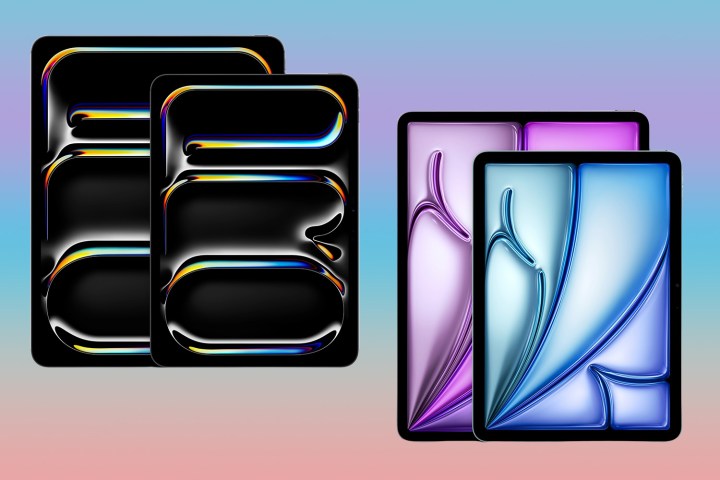
During its “Let Loose” event on May 7, Apple added four new iPad models to its tablet lineup. The latest models include an 11-inch and all-new 13-inch iPad Air and next-generation 11-inch and 13-inch iPad Pro models. Despite sharing similar dimensions, there’s a significant price gap between the least expensive iPad Air and iPad Pro tablets, indicating notable differences between the two lineups.
Screen size is usually a main focus for users when choosing an iPad. The recent release of the 13-inch iPad Air offers a new option for those who have been looking for an Apple tablet with a larger scree,n but couldn’t justify the cost of an iPad Pro. On the other hand, some people might have been waiting patiently for the first iPads with OLED screens, which have now been introduced — although they come with a higher price tag.
In this article, we will examine the differences between this year’s iPad Air and iPad Pro lineups — and help determine which is the better purchase for you.
iPad Pro (2024) vs. iPad Air (2024): specs
| iPad Pro (2024) | iPad Air (2024) | |
| Size | 11-inch 9.83 x 6.99 x 0.21 inches (249.7 x 177.5 x 5.3 mm) 13-inch 11.09 x 8.48 x 0.20 (281.6 x 215.5 x 5.1 mm) |
11-inch: 9.74 x 7.02 x 0.24 inches (247.6 x 178.5 x 6.1 mm) 13-inch: 11.04 x 8.46 x 0.24 inches (280.6 x 214.9 x 6.1 mm) |
| Weight | 11-inch: 0.98 pounds (444 grams) 13-inch: 1.28 pounds (579 grams) |
11-inch: 1.02 pounds (462 grams) 13-inch: 1.36 pounds (618 grams) |
| Screen size |
11-inch: Ultra Retina XDR display/Tandem OLED |
11-inch Liquid Retina display 13-inch Liquid Retina display |
| Screen resolution | 11-inch: 2420 x 1668 resolution at 264 ppi 13-inch: 2752 x 2064 resolution at 264 ppi |
11-inch: 2360 x 1640 resolution at 264 ppi 13-inch: 2732 x 2048 resolution at 264 ppi |
| Brightness |
SDR brightness: 1000 nits max XDR brightness: 1000 nits max full screen, 1600 nits peak (HDR content only) |
SDR brightness: 600 nits max |
| Operation system | iPadOS 17 | iPadOS 17 |
| Storage space | 256GB, 512GB, 1TB, 2TB | 128GB, 256GB, 512GB, 1TB |
| Processor | M4 chip with 16-core Neural Engine, up to 10-core CPU, 10-core GPU | M2 chip with 16-core Neural Engine, 8-core CPU, 10-core GPU |
| RAM | 256GB/512GB: 8GB RAM 1TB/2TB: 16GB RAM |
8GB |
| Camera | 12MP Wide camera Landscape 12MP Ultra Wide Front Camera |
12MP Wide camera Landscape 12MP Ultra Wide Front Camera |
| Video | 4K video, ProRes | 4K |
| Bluetooth | Bluetooth 5.3 | Bluetooth 5.3 |
| Ports | USB‑C connector with support for Thunderbolt / USB 4 | USB‑C connector |
| Authentication | Face ID | Touch ID in the top button |
| SIM card | eSIM | eSIM |
| Audio | Four speaker audio Four studio-quality microphones |
Landscape stereo speakers Two microphones 2x bass on 13-inch model |
| Battery life | Up to 10 hours of surfing the web on Wi-Fi or watching video | Up to 10 hours of surfing the web on Wi-Fi or watching video |
| Network | Wi-Fi 6E / 5G Cellular | Wi-Fi 6E / 5G Cellular |
| Apple Pencil support | Apple Pencil Pro Apple Pencil (USB-C) |
Apple Pencil Pro Apple Pencil (USB-C) |
| Magic Keyboard support | Magic Keyboard for iPad Pro (M4) | Magic Keyboard |
| Colors | Space Black, Silver | Purple, Blue, Starlight, Space Gray |
| Price | 11-inch: from $999 13-inch: from $1,299 |
11-inch: from $599 13-inch: from $799 |
iPad Pro (2024) vs. iPad Air (2024): display
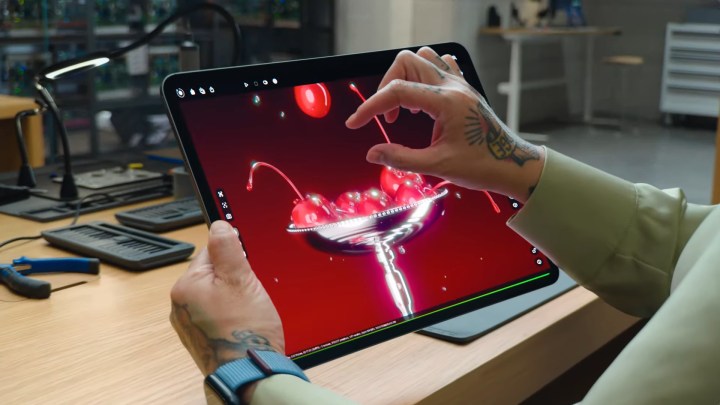
The latest iPad Pro models are equipped with OLED technology, which Apple calls the Ultra Retina XDR display. These models also feature a new Tandem OLED technology, which involves stacking two OLED panels on top of each other. This results in higher brightness, improved color accuracy, and a longer life span for the display.
The 11-inch iPad Pro has a resolution of 2420 x 1668 and 264 pixels per inch (ppi). It offers a standard dynamic range (SDR) brightness of up to 1,000 nits and an extended dynamic range (XDR) brightness of up to 1,600 nits for HDR content. The 13-inch iPad Pro features a resolution of 2752 x 2064 and 264 ppi and the same brightness levels as the 11-inch model.
If you purchase an 11-inch or 13-inch iPad Pro with 1TB or 2TB of storage, you can select the Nano-texture display glass option, which can reduce glare. Both also offer ProMotion technology for a 120Hz refresh rate, which isn’t available on the iPad Air.

The new iPad Air models, like the 2022 iPad Air, have Liquid Retina displays. They boast an LED-backlit Multi-touch display with IPS technology. The 11-inch model offers a resolution of 2360 x 1640 at 264 pixels per inch, while the 13-inch model features a resolution of 2732 x 2048 (264 ppi). They both provide a brightness of 600 nits in SDR mode, which is a slight improvement over the fifth-generation iPad Air, which had a brightness of 500 nits.
As you can see, the iPad Pro and iPad Air lines have noticeable differences in their displays. First, Apple has finally introduced OLED to the iPad Pro, which many users have eagerly awaited. Second, both iPad Pro models now have the same display quality, unlike the previous versions, where the 12.9-inch model had a Liquid Retina XDR display, while the 11-inch model had a Liquid Retina display.
It’s worth noting, however, that the iPad Air lineup still uses the Liquid Retina display instead of the Liquid Retina XDR display. The SDR brightness of the 2024 iPad Air matches the previous iPad Pro models, which is a positive aspect to consider.
iPad Pro (2024) vs. iPad Air (2024): performance, battery life, charging

The new iPad Pro series boasts the cutting-edge M4 Apple silicon. This advanced chip delivers a staggering four times the pro rendering experience compared to the M2 chip in the iPad Air and a significant 1.5 times the CPU performance.
The iPad Pro models have a powerful processor consisting of three or four performance cores and six efficiency cores. The 256GB and 512GB models feature a nine-core CPU with 8GB of RAM, while the 1TB and 2TB models come with a 10-core CPU with 16GB of RAM. These models have a 10-core GPU, a memory bandwidth of 120GB/s, and a 16-core Neural Engine.
The iPad Air has an eight-core CPU with four performance and four efficiency cores. It also has 8GB RAM, a 10-core GPU, a 16-core Neural Engine, and a memory bandwidth of 100GB/s.
There is no discernible difference in battery performance between the iPad Pro and iPad Air. Both models offer up to 10 hours of web surfing on Wi-Fi or video playback and up to nine hours of usage with the cellular data network. Charging is done via USB-C to a computer or power adapter.
iPad Pro (2024) vs. iPad Air (2024): cameras and video
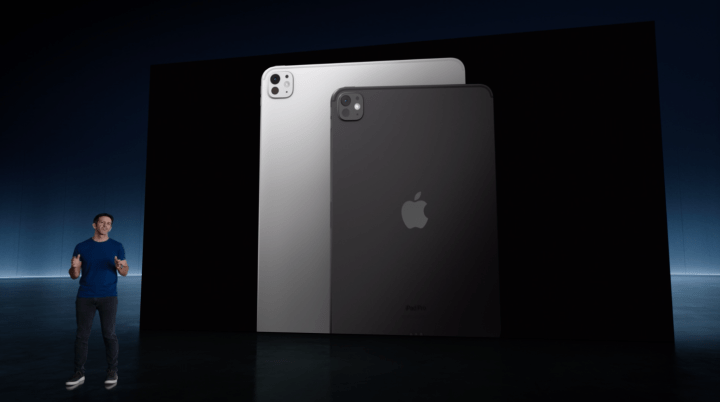
Once you dig deeper into the specs, you will find a few important differences between the camera systems of the iPad Pro and iPad Air. Both devices have 12MP Wide and Landscape Ultrawide front cameras. The former has a digital zoom of up to 5x, f/1.8 aperture, and Smart HD4 for photos, while the front camera offers 12MP photos, Center Stage, and f/2.4 aperture with 2x zoom.
If you want to distinguish between the iPads regarding the camera, there are a few unique features. The Adaptive True Tone flash on the rear camera is only available on the iPad Pro. The front camera on the iPad Pro features a Portrait mode with advanced bokeh and Depth Control, as well as Portrait Lighting with six effects.
Unsurprisingly, the iPad Pro has superior video recording capabilities compared to the iPad Air. Both the iPad Air and iPad Pro allow for 4K video recording at 24 frames per second (fps), 25 fps, 30 fps, or 60 fps, 1080p HD video recording at 25 fps, 30 fps, or 60 fps, and extended dynamic range for video up to 30 fps. They also include Slo-mo video support for 1080p at 120 or 240 fps and time-lapse video with stabilization.
However, the iPad Pro is the only model that allows ProRes video recording up to 4K at 30 fps (1080p at 30 fps for 256GB capacity), ProRes video recording up to 4K at 60 fps with external recording, audio zoom, and stereo recording.
iPad Pro (2024) vs. iPad Air (2024): accessories
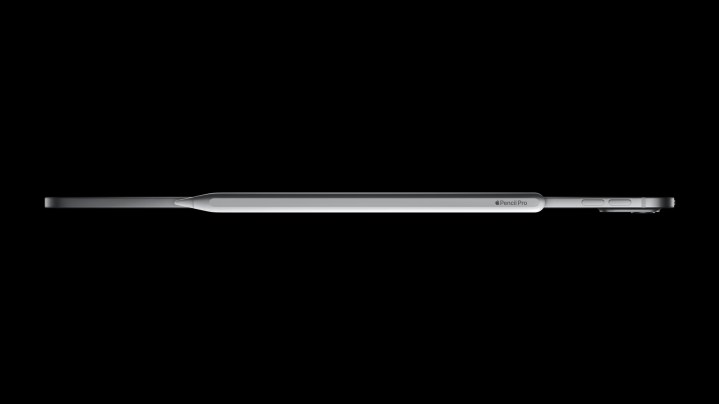
To complement the new iPads, Apple also launched a new Apple Pencil Pro that’s compatible with both models. However, if you want a more affordable option, you can use the less expensive Apple Pencil (USB-C) with either device.
It’s important to note that the newest Magic Keyboard is only compatible with the iPad Pro models due to its new materials and design. If you opt for the iPad Air, you must purchase the older Magic Keyboard instead.
iPad Pro (2024) vs. iPad Air (2024): software and updates

The iPad Pro and iPad Air are equipped with the latest version of iPadOS, and Apple will continue to release updates for both devices for many years. Both tablets ship with iPadOS 17 out of the box and will be updated to iPadOS 18 later this year.
While Android devices tend to have a set number of guaranteed software updates, Apple’s do not. History, however, tells us that both models will support software updates for a long time. For example, the 2017 iPad Pro 10.5-inch and 2019 iPad Air can still run the latest iPadOS version.
iPad Pro (2024) vs. iPad Air (2024): price and availability
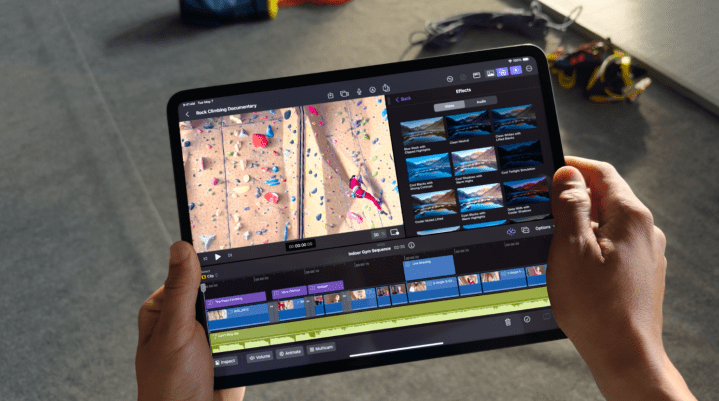
The iPad Pro has four storage options: 256GB, 512GB, 1TB, and 2TB. It is available in Space Black or Silver. The 11-inch version costs $999, while the larger one costs $1,299. Adding Wi-Fi + Cellular will add $200 on top of each model’s base price.
On the other hand, the entry-level 11-inch iPad Air costs $599, while the larger model costs $799. Adding Wi-Fi and Cellular features will add $150 to the base price of each model. It comes in Space Gray, Blue, Purple, and Starlight.
Preorders for the 2024 iPad Pro and iPad Air are open now. The first shipments arrive the week of May 13.
iPad Pro (2024) vs. iPad Air (2024): which one should you buy?
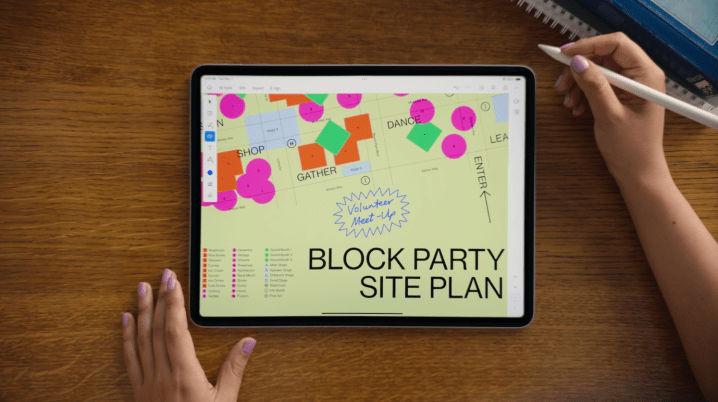
The 2024 iPad Pro and iPad Air series have become more different from each other than ever before, as evidenced by the significant price difference between the two. For a higher cost, iPad Pro users will receive several advantages, such as an OLED display, a thinner design, improved camera and video capabilities, and, most importantly, a better-performing M4 system-on-a-chip (SoC). The iPad Pro can also utilize Apple’s all-new Magic Keyboard and access more RAM.
Although lacking these upgrades, the 2024 iPad Air still offers a high-quality experience. It may not have all the bells and whistles of the iPad Pro, but it’s a solid choice for those who want a reliable and capable device without breaking the bank.
If you’re considering buying an iPad and are unsure which one to choose, the iPad Air is the best option for most people; it has everything you need for everyday casual use. However, if you rely heavily on photo and video editing and need the best possible performance, then the iPad Pro is the right choice. It’s also the best option if you want to have Apple’s latest technology. Just be prepared to pay a pretty penny for it.
Editors’ Recommendations










